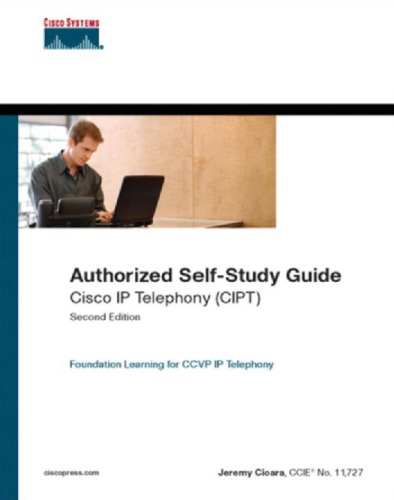

Most ebook files are in PDF format, so you can easily read them using various software such as Foxit Reader or directly on the Google Chrome browser.
Some ebook files are released by publishers in other formats such as .awz, .mobi, .epub, .fb2, etc. You may need to install specific software to read these formats on mobile/PC, such as Calibre.
Please read the tutorial at this link: https://ebookbell.com/faq
We offer FREE conversion to the popular formats you request; however, this may take some time. Therefore, right after payment, please email us, and we will try to provide the service as quickly as possible.
For some exceptional file formats or broken links (if any), please refrain from opening any disputes. Instead, email us first, and we will try to assist within a maximum of 6 hours.
EbookBell Team

4.4
12 reviews 
ISBN 10: 158705261X
ISBN 13: 978-1587052613
Author: Jeremy Cioara, Cisco Systems
Part I: Cisco CallManager Fundamentals
Introduction to Cisco Unified Communications and Cisco Unified CallManager
Cisco Unified Communications
Understanding Cisco Unified CallManager
The Two Sides of the Cisco Unified CallManager Cluster
Cluster Redundancy Designs
Call-Processing Deployment Models
Cisco Unified CallManager 4.x Clean Installation Process
Upgrading Prior Cisco Unified CallManager Versions
Part II: IPT Devices and Users
Cisco IP Phones
IP Phone Startup Process
Cisco IP Phone Codec Support
Configuring Intracluster IP Phone Communication
IP Phone Configuration
Case Study: Device Pool Design
Cisco CallManager User Database
Cisco CallManager User Configuration
User Logon and Device Configuration
The Cisco Bulk Administration Tool
Using the Tool for Auto-Registered Phone Support
Part III: IPT Network Integration and Route Plan
Catalyst Switch Role in IP Telephony
Powering the Cisco IP Phone
Data and Voice VLANs
Configuring Class of Service
Cisco Gateway Concepts
Configuring Access Gateways
Cisco Trunk Concepts
Configuring Intercluster Trunks
SIP and Cisco CallManager
External Call Routing
Route Plan Configuration Process
Route Filters
Discard Digit Instructions
Transformation Masks
Translation Patterns
Route Plan Report
Call Distribution Components
Configuring Line Groups, Hunt Lists, and Hunt Pilots
Class of Service Overview
Partitions and Calling Search Spaces Overview
Time-of-Day Routing Overview
Configuring Time-of-Day Routing
Time-of-Day Routing Usage Scenario
Call Admission Control
Survivable Remote Site Telephony
Part IV: VoIP Features
Introduction to Media Resources
Conference Bridge Resources
Media Termination Point Resources
Annunciator Resources
Transcoder Resources
Music on Hold Resources
Media Resource Management
Basic IP Phone Features
Softkey Templates
Enhanced IP Phone Features
Barge and Privacy
IP Phone Services
Cisco CallManager Extension Mobility
Client Matter Codes and Forced Authentication Codes
Call Display Restrictions
Malicious Call Identification
Multilevel Precedence and Preemption
Introduction to Cisco CallManager Attendant Console
Call Routing and Call Queuing
Server and Administration Configuration
Cisco Attendant Console Features
Cisco IP Manager Assistant Overview
Cisco IP Manager Assistant Architecture
Configuring Cisco IPMA for Shared-Line Support
Part V: IPT Security
Threats Targeting the Operating System
Security and Hot Fix Policy
Operating System Hardening
Antivirus Protection
Cisco Security Agent
Administrator Password Policy
Common Windows Exploits
Security Taboos
Securing CallManager Communications Using HTTPS
Multilevel Administration
Toll Fraud Exploits
Preventing Call Forward and Voice-Mail Toll Fraud
Blocking Commonly Exploited Area Codes
Using Time-of-Day Routing
Using FAC and CMC
Restricting External Transfers
Dropping Conference Calls
Threats Targeting Endpoints
Blocking Endpoint Attacks
What Is Cryptography?
Symmetric and Asymmetric Encryption
Hash Functions
Digital Signatures
The Need for a PKI
PKI as a Trusted Third-Party Protocol
PKI Entities and Enrollment
PKI Revocation and Key Storage
Threats Targeting the IP Telephony System
How CallManager Protects Against Threats
PKI Topologies in Cisco IP Telephony
PKI Enrollment in Cisco IP Telephony
Authentication and Integrity
Encryption
Authentication and Encryption Configuration Overview
Enabling Services Required for Security
Using the CTL Client
Working with Locally Significant Certificates
Configuring the Device Security Mode
Negotiating Device Security Mode
Generating a CAPF Report
Part VI: IP Video
IP Video Telephony Solution Components
Video Call Concepts
Video Protocols Supported in Cisco CallManager
Bandwidth Management
Call Admission Control Within and Between Clusters
Cisco VT Advantage Overview
How Calls Work with Cisco VT Advantage
Configuring Cisco CallManager and IP Phones for Video
Installing Cisco VT Advantage on a Client
Part VII: IPT Management
Database Management Tools
Cisco CallManager Serviceability Overview
Tools Overview
Performance Counters
Microsoft Event Viewer
Microsoft Performance Monitor
Real-Time Monitoring Tool Overview
Alarm Overview and Configuration
Trace Configuration and Analysis
Bulk Trace Analysis and Tools
CAR Overview and Configuration
Report Scheduling
System and User Report Configuration
Remote Management Tools
Dependency Records
Password Changer Tool
Cisco Dialed Number Analyzer
Quality Report Tool
cisco study guides
cisco self study
cisco self paced courses
cisco self study guide
cisco ccna security self-study prep
cisco guided study groups
Tags: Jeremy Cioara, Cisco Systems, Authorized, Self Study, Guide, IP, Telephony, CIPT